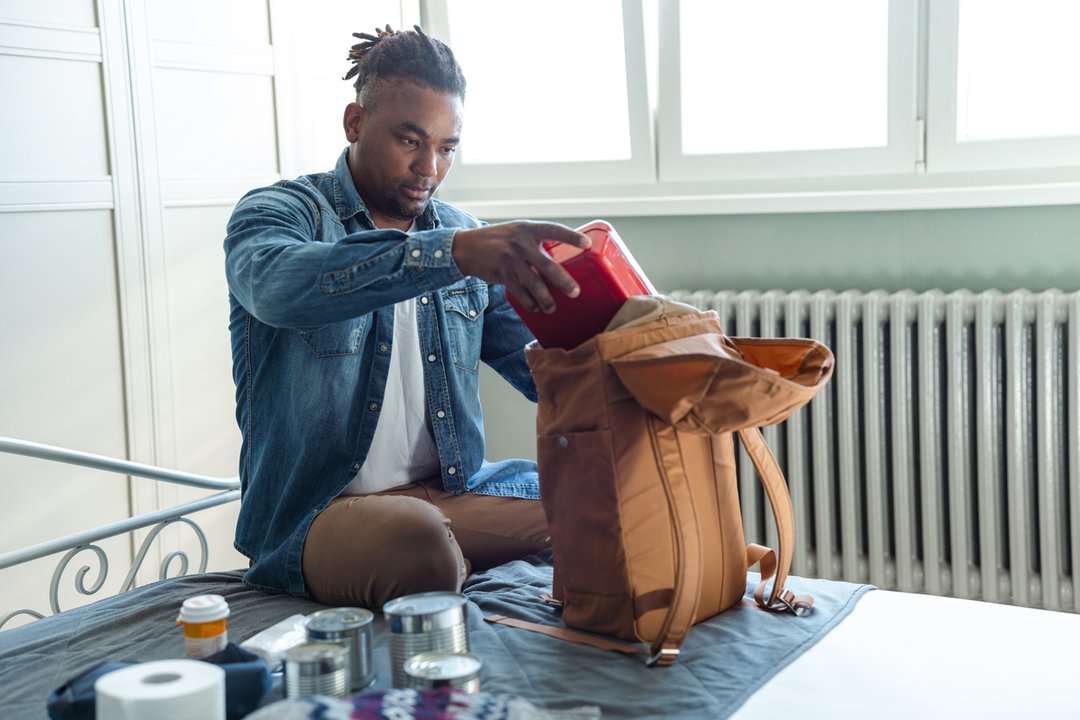
News about the fires in Los Angeles is inescapable. You might feel powerless when watching the news or reading social media, only to learn about how the disaster has destroyed homes and livelihoods in the blink of an eye. But there’s one thing you can take action on right now: Ensure you are prepared for the worst.
“Leaving in a hurry due to a disaster can be a very disorienting experience,” says Steve Powell, President of EFI Global, Inc. and EVP, Property, Americas, for Sedgwick. “But preparing for the unexpected by putting together a go bag helps you avoid the chaos of scrambling for last-minute items on your way out.”

iStock image
The go bag concept isn’t new, but interest in this simple disaster preparedness tool is off the charts given the increasing frequency, severity, and coverage of climate-driven disasters in recent years. For those new to the term, it’s quite literally just a bag that you fill with supplies you might need to get by during an emergency evacuation.
Here’s a new take for your go bag planning: Besides emergency supplies, include essential paperwork, financial information, and other irreplaceable resources that could aid in the process of rebuilding your home and your financial life. Here’s what you need to know about strengthening your go bag.
7 things to keep in your go bag
Forget the emergencies for a moment and imagine that you’re leaving your home on an ordinary day. What do you take with you? Glasses, wallets, and keys, possibly lunch. Building your personal go bag works in a similar fashion, but consider items that would help in an emergency—including essential financial information.
“A go bag can also be a key tool to make sure you have clean clothes for a few days and a stash of cash, which is essential in the aftermath of disaster,” says Powell.
Here’s a short list of things we believe you should add to your go bag:
- Non-perishable food. Hunger makes the wild emotions of a rushed evacuation even more challenging to deal with. Keep water and snacks on hand so you stay sharp through the chaos.
- Identification information. According to Powell, you’ll want to make sure you have copies of your ID, birth certificates, and other documentation that proves who you are and what you own. “This will help the recovery and claims process smoother down the road,” he advises.
- Cash. “During disasters, the loss of electrical power is common. Credit cards and ATMs are rendered temporarily unless,” says Powell. Keeping a supply of cold, hard cash in your go bag will make sure you can buy what you need if electronic systems are unavailable. Choose an amount based on the number of people you need to provide for; a single person won’t need to stash away much in comparison to a family of six.
- Banking information and insurance policy numbers. Much of this information is stored on our computers these days, but if those are destroyed you risk losing track of them entirely. You’ll want to prepare a document that lists out every institution where you hold an account, and keep a record of policy numbers at each insurance company you use.
Diane Delaney, executive director of the Private Risk Management Association (PRMA), adds to this by saying, “It’s smart to document the contents of your home for insurance purposes. A quick video of your belongings can serve as an invaluable record if you need to file a claim.” - Medical information. It may be a while before you can get in touch with your doctor, and in the event you need immediate medical care it will be vital to provide emergency services with information such as allergies, prescriptions, and pre-existing conditions. And don’t just list out the health history of the people in your home—make sure you note the details for your furry friends, as well.
- Emergency contacts. If your phone, tablet, computer, and other electronics are destroyed, chances are you don’t have many phone numbers memorized these days and might struggle to get in touch with important connections. Make sure you have a list of names and phone numbers for close family and friends, as well as professional connections you may need to contact such as brokers, lawyers, and insurance agents.
- Weather radio with flashlight. There are an abundance of things that can lead to power outages, and trying to navigate a dangerous situation in the dark exponentially increases the risk of injury or even death. Pick up a weather radio with a built-in flashlight from the National Oceanic and Atmospheric Administration (NOAA) to stay in touch with officials about rapidly changing situations.
Other nice-to-have additions to your go bag could include:
- Personal hygiene items can go a long way toward making you feel more comfortable in a tough situation.
- Photos of pets are crucial in the unfortunate circumstance you are separated during an evacuation.
- Spare keys to buildings and vehicles will make them easy to access instead of relying on a locksmith.
- A checkbook can come in handy in emergencies. Even though checks are rather defunct, they still have their uses.
Naturally, this is only scraping the surface and there are plenty of other things you should consider when preparing for the unexpected. Delaney recommends that homeowners should check out the resources from Ready.gov, a website operated by the U.S. Department of Homeland Security, for additional tips.
Store your go bag somewhere safe
It’s a good idea to keep as much of your documentation as possible inside a waterproof fire safe that will protect it from the elements in an emergency. You might even use waterproof bags inside the safe for an extra layer of protection.
Once you have everything together, find your go bag a safe place to live inside your home where it won’t be easily damaged or stolen. Delaney recommends avoiding vulnerable locations such as garages or filing cabinets, and Powell adds that you should store it at least three feet above the floor. “This will help reduce the chances of the bag getting damaged upon water entering your home,” he says.
“Avoid putting your go bag in a location that gets cluttered with other items. It needs to be readily accessible to your easiest path of exit,” says Powell.
Safe deposit boxes aren’t necessarily the best option
Personally, I’ve been storing many of my sensitive documents at the local bank, locked up tight in a vault. But Kelsey Simasko, attorney at Simasko Law, points out that there are significant drawbacks to this being your sole plan.
“If your home is facing a natural disaster, then it’s likely the local bank is too,” says Simasko. “Furthermore, if you need any of those documents in a hurry and the bank is closed, you have absolutely no way to access them.”
Delaney agrees, adding an important factor that may be especially important for families with children to consider in case of emergency: “Should something happen to you, it is difficult for someone else to access your safe deposit box.”
Consider maintaining a digital backup
No matter how much you prepare, there’s always the chance that it just won’t be safe enough to gather your go bag before an evacuation and you’ll be forced to leave it behind. It’s wise to create digital copies of your information, but make sure you don’t only store the files locally (on your own hard drive).
“Using an encrypted drive or cloud-based storage with strong encryption is ideal for digital storage,” says Delaney. “Even if your computer is lost or damaged, you can still access these files. Look for a service that offers zero-knowledge encryption, which ensures only you can access your documents. It’s a reliable way to keep your information secure and accessible when you need it most.”
Keep your go bag current
Setting up your financial go bag isn’t a one-time deal; you should be prepared to keep your information updated over time. If you change bank accounts, insurance policies, or have significant changes to your medical history, make sure to update your documentation accordingly. You don’t want to be faced with an emergency, only to discover that everything you put together is outdated.
And if the process of keeping it all updated is frustrating, just remember the phrase, “better to have it and not need it, than need it and not have it.” If the worst should happen, you’ll be grateful you put in the effort.
This story was originally featured on Fortune.com
c.2025 Fortune Magazine. Distributed by The New York Times Licensing Group.
Comments are closed.
